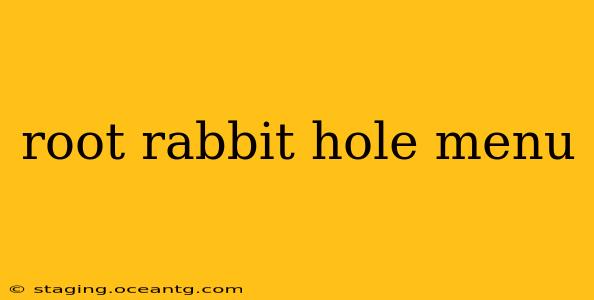The "root rabbit hole menu" is a term often used in the context of computer systems, particularly Linux and other Unix-like operating systems. It refers to the hierarchical file system structure, often visualized as a tree, starting from the root directory, denoted by a forward slash /. Navigating this structure effectively is crucial for any user working within these systems. This guide will delve into understanding and mastering this essential aspect of command-line interfaces.
What is the Root Directory (/)?
The root directory, represented by the / symbol, is the top-level directory in a hierarchical file system. Think of it as the trunk of a tree, with all other directories and files branching out from it. It contains crucial system directories like /bin (containing essential commands), /dev (device files), /etc (configuration files), /home (user home directories), /lib (system libraries), /proc (process information), /root (the root user's home directory), /tmp (temporary files), /usr (user programs and data), /var (variable data like logs), and more. Understanding the purpose of each of these subdirectories is vital for efficient system administration and troubleshooting.
How to Navigate the Root Rabbit Hole Menu?
Navigating the root directory and its subdirectories is primarily done using the command line. The most important commands are cd (change directory) and ls (list directory contents).
-
cd /: This command changes your current directory to the root directory. This is your starting point for exploring the entire file system. -
cd /path/to/directory: This command changes the directory to the specified path. For example,cd /etcwill take you to the/etcdirectory, which contains crucial system configuration files. -
ls: This command lists the contents of the current directory, showing files and subdirectories. Options likels -l(long listing) provide more detailed information, such as file permissions and modification times. -
pwd: This command (print working directory) displays your current location within the file system. This is helpful to keep track of where you are. -
..: This represents the parent directory.cd ..will move you one level up in the directory hierarchy.
Common Root Directory Locations and Their Purposes
Here's a breakdown of some key directories found under the root:
/bin (binaries)
This directory contains essential system commands that are available to all users.
/boot (bootloader)
This holds files necessary for the system to boot up.
/dev (devices)
This contains special files representing hardware devices, such as hard drives, keyboards, and network interfaces.
/etc (configuration)
This houses system-wide configuration files.
/home (user home directories)
This contains the home directories for each user on the system.
/lib (libraries)
This stores essential system libraries required by programs.
/proc (process information)
A virtual filesystem providing information about running processes.
/root (root user's home)
The home directory of the root user (administrator).
/tmp (temporary files)
This is where temporary files are stored. These files are often automatically deleted on reboot.
/usr (user programs and data)
This directory contains user programs, libraries, and documentation.
/var (variable data)
This directory holds data that changes frequently, such as log files, spool directories, and databases.
What are the risks of navigating the root directory?
Navigating the root directory incorrectly can lead to system instability. Incorrectly modifying files in the /etc, /bin, or other critical directories can render the system unusable. Always proceed with caution and have a backup plan if you are making changes. Only users with root or administrator privileges should modify files in many of these directories.
How do I find specific files in the root directory?
To find specific files, you can use the find command. For instance, find / -name "myfile.txt" searches for a file named "myfile.txt" starting from the root directory. The -name option specifies the filename pattern to search for. Other options can refine your search based on file type, modification time, and more.
Understanding the root rabbit hole menu is a cornerstone of effective system administration. By mastering the basic commands and the purpose of the key directories, you can effectively navigate and manage your system. Remember to always exercise caution and back up your data before making significant changes within the root directory.
